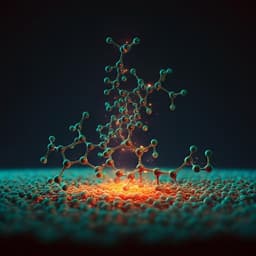
Chemistry
Solvent-Pair Surfactants Enabled Assembly of Polyoxometalates and Amphiphilic Block Copolymers for the Synthesis of Functional Mesoporous Metal Oxides
W. Xu, Y. Ren, et al.
Discover the innovative 'solvent-pair surfactants' enabled assembly method, or SPEA, developed by Wentao Xu and colleagues. This groundbreaking approach enables the synthesis of functional mesoporous metal oxides with superior performance in acetone sensing. Explore how binary solvent systems can revolutionize the assembly of polyoxometalates and amphiphilic block copolymers, paving the way for versatile designs in various applications.
~3 min • Beginner • English
Introduction
The study addresses limitations in current strategies for constructing ordered mesostructured inorganic materials using amphiphilic block copolymer templates, which often depend on direct host-guest interactions (covalent bonding, hydrogen bonding, pi-pi stacking, Coulombic interactions) and require strict control over synthesis parameters, limiting flexibility and compositional diversity. Polyoxometalates (POMs), nanosized metal-oxo clusters with various counter-cations (acidic and non-acidic), have emerged as promising inorganic precursors, but direct Coulombic interactions between acidic POM anions and protonated copolymers restrict broad synthesis conditions. The research proposes a general, versatile copolymer-templating route suitable for various POM precursors by employing binary organic solvent/water pairs to mediate indirect interactions and enable ordered mesostructure formation and conversion into mesoporous metal oxides (mMOs) with rich compositions and pore architectures.
Literature Review
Previous assembly methods for inorganic/copolymer systems rely on direct host-guest interactions and subsequent crosslinking/condensation, making them sensitive to solvent polarity, additives, temperature, and humidity. Acidic POMs have been assembled with copolymers in polar solvents via Coulombic attraction, enabling some mMO syntheses, but with limited conditions and compositional scope. Organic solvents like small alcohols and THF are macroscopically miscible with water but show microscopic heterogeneity and water clustering, which causes non-acidic POMs to aggregate and precipitate. In contrast, strong hydrogen bonding between DMF and water at low water content (<20 vol%) disrupts the bulk water network to form stable DMF-nH2O complexes. These insights motivate using specific solvent pairs to overcome solubility and interaction constraints and broaden assembly generality.
Methodology
Concept and assembly: The authors develop a solvent-pair surfactants enabled assembly (SPEA) using amphiphilic block copolymers (AB copolymers) and POM precursors in binary organic solvent/water systems (e.g., DMF/H2O with water <20 vol%). In such systems, DMF-water form stable complexes (DMF-nH2O) that behave like molecular surfactants, with water acting as the hydrophilic head interacting via hydrogen bonding with oxygen-rich POM surfaces and DMF as the tail in the organic-rich medium. These complexes solubilize non-acidic POMs and indirectly mediate their selective accumulation around hydrophilic copolymer blocks (e.g., PEO) during solvent evaporation, enabling ordered POMs/AB copolymer mesostructures. Subsequent calcination in N2 (to pyrolyze the polymer and decompose POMs) followed by air (to remove carbon) yields ordered mesoporous metal oxides (mMOs). Counter-cations from POMs participate and can be retained as dopants or intercalants in the final mMOs.
Solvent selection and simulations: Organic solvents capable of dissolving AB copolymers are categorized: (1) DMF-like solvents forming strong hydrogen-bonding complexes with water and mixing at the molecular level; (2) solvents immiscible with water at the molecular scale; (3) solvents immiscible at the macroscopic scale. DFT calculations (molecular electrostatic potentials, dipole moments) show first-type solvents have larger dipole moments and more negative potentials than water, enabling stronger solvent-water interactions. Interaction energies indicate DMF-water complexes are more stable than THF-water. MD simulations confirm complete molecular mixing for DMF-water with no phase separation, whereas THF-water forms water clusters.
Mechanistic insights: Non-acidic POMs with relatively low surface charge density form hydrogen bonds with water but do not disrupt DMF-water complexes; the complexes coat POMs and mediate their localization near hydrophilic polymer domains (e.g., PEO) during evaporation-induced packing of copolymer micelles into ordered structures (typically fcc for spherical micelles). Ordinary high-charge-density metal oxoanions (e.g., WO4^2−, SnO3^2−) are insoluble in DMF-water due to breaking the solvent complexes, causing microscopic phase separation and precipitation. For acidic POMs, PEO blocks are protonated and directly interact via Coulombic attraction with POM anions to form composite micelles that assemble into ordered mesostructures upon evaporation.
Materials and general synthesis: Various AB copolymers (nonionic: PEO-b-PS, PEO-b-PMMA, PEO-b-PB; ionic: PS-b-P4VP, PS-b-PAA) are applicable. Solvents include DMF and similar first-type solvents (e.g., DMA, pyridine, DMSO, N,N-diethylformamide, N-methylpyrrolidone). POM precursors include non-acidic types such as (NH4)6Mo7O24·4H2O, (NH4)10H2W12O42, (NH4)6V10O28, Na3H2W12O40, Na2PW12O40, Na4V10O28, K4V10O28, K8Mo8O26, Li6V10O28; and acidic types such as H3PW12O40, H4SiMo12O40, H3PMo12O40.
Prototype synthesis of mN-WO3: A typical route uses PEO114-b-PS200 (0.05 g) dissolved in DMF (4.5 mL), combined with (NH4)6H2W12O40 in water (0.15 g in 0.5 mL), mixed at a PEO-b-PS/POM mass ratio of 1:3. After stirring (1 h), the colloidal solution is cast and solvent-evaporated at 40 °C for 24 h, then heated at 100 °C for 24 h. Calcination: 500 °C for 0.5 h in N2 (1 °C/min below 350 °C, 5 °C/min above 350 °C), then 400 °C for 0.5 h in air (5 °C/min) to form ordered nitrogen-doped mesoporous WO3 (mN-WO3).
Characterization: Morphology and structure characterized by FESEM, TEM, HRTEM, ac-HAADF-STEM, SAXS, XRD, Raman. Composition/doping by EDX mapping, XPS (N 1s at ~400 eV attributed to W–O–N; absence of N–H FTIR peaks), UV-Vis DRS (band gap changes), XAFS (W L3-edge EXAFS for coordination and local structure). Porosity by N2 adsorption–desorption (BET surface area, BJH pore size). Thermal stability up to 700 °C assessed. DFT used to evaluate N-doping energetics (interstitial favored). Gas-sensing performance assessed using side-heated alumina tube devices with Au electrodes; response and recovery metrics measured for acetone at 300 °C.
Extensibility: By varying polymer block lengths (especially PS segment of PEO-b-PS), pore sizes (approximately 12.1–33.2 nm) and geometries (spherical, cylindrical, lamellar) are tuned. The approach enables heteroatom-doped mMOs (e.g., P- or Si-doped), cation-intercalated oxides (e.g., Na-, K-, Li-containing frameworks), metal oxide composites, and noble metal-loaded mMOs.
Key Findings
- A general SPEA strategy using DMF/water (and other first-type solvent/water pairs) enables indirect co-assembly of non-acidic POMs with AB copolymers into ordered mesostructures via solvent-pair complexes acting as surfactants.
- MD simulations and DFT confirm strong DMF-water interactions, stable molecular-level mixing, and the formation of DMF-nH2O complexes; THF-water shows water clustering and inferior compatibility for POM dissolution.
- Broad generality: multiple AB copolymers (PEO-b-PS, PEO-b-PMMA, PEO-b-PB, PS-b-P4VP, PS-b-PAA) and many POMs (acidic and non-acidic) form ordered composites that convert to mMOs with uniform mesostructures; simultaneous use of different POMs is also feasible.
- Prototype mN-WO3 exhibits ordered fcc mesoporous architecture with interconnected spherical pores and iso-oriented nanocrystalline walls. Pore size tunable from 12.1 to 33.2 nm by varying PS block length; typical sample shows uniform ~20.9 nm pores and type-IV N2 isotherm with H2 hysteresis.
- Thermal stability: iso-oriented walls confer ultrahigh stability up to 700 °C (nitrogen), outperforming control mWO3 made from WCl6 (polycrystalline walls, partial collapse at 700 °C).
- Doping and crystal phase: Ammonium counter-cations provide nitrogen leading to homogeneous N-doping (W–O–N, XPS N 1s ~400 eV). mN-WO3 adopts ferroelectric epsilon-WO3, while control mWO3 is gamma-phase; N doping slightly reduces band gap from 2.70 to 2.63 eV.
- XAFS indicates similar W–O coordination but distinct local atomic/electronic structure in mN-WO3 vs mWO3 due to N incorporation; DFT supports N interstitial as the most favorable doping site.
- Gas sensing: mN-WO3 shows high acetone sensitivity S = 103.7 at 50 ppm and detectable response at 10 ppb (S = 1.9) at 300 °C, with fast response/recovery (15/35 s) and good selectivity; control mWO3 shows much lower and slower response.
- Product library: diverse cation-intercalated and heteroatom-doped mMOs (e.g., Na2W4O13·8H2O, Na2W2O7, NaVO3, K2Mo3O10, K8Mo8O26, LiV3O8) prepared; some (e.g., K2Mo3O10, LiV3O8) show short-range order due to limited precursor solubility and fast crystallization; acidic POMs yield P- or Si-doped MoO3/WO3 via Coulombic assembly.
Discussion
The SPEA approach directly addresses the challenge of constructing ordered mesostructured metal oxides from POMs across a wide set of conditions and compositions. By shifting from direct host-guest interactions to indirect mediation via solvent-pair complexes, non-acidic POMs become soluble and position-selective around hydrophilic polymer blocks, enabling robust, ordered assemblies that survive conversion to crystalline oxides. The selective localization and subsequent crystalline–crystalline transformation of POMs promote iso-oriented walls, improving thermal stability and charge/mass transport compared to conventional amorphous–crystalline routes. Incorporation of counter-cations during assembly provides a facile path to heteroatom doping and cation intercalation, tuning electronic structure (e.g., N-doping stabilizing epsilon-WO3 and narrowing band gap) and thereby enhancing functional properties such as gas sensing. The generality across polymers, solvent systems, and POM chemistries, along with tunable pore architectures, highlights the method’s versatility for applications in catalysis, sensing, and energy storage. The findings demonstrate that carefully designed solvent environments can extend supramolecular assembly to systems previously hindered by solubility and interaction constraints.
Conclusion
The work introduces a solvent-pair surfactants enabled assembly (SPEA) that generalizes the co-assembly of POMs with AB copolymers to synthesize ordered mesoporous metal oxides with tunable pore sizes, structures, and compositions. Stable organic solvent/water complexes (e.g., DMF-nH2O) act as molecular surfactants, enabling non-acidic POM dissolution and indirect interaction with hydrophilic polymer segments, yielding ordered mesostructures that persist through conversion to crystalline oxides. The approach delivers materials with iso-oriented nanocrystalline walls, high thermal stability, and functional enhancements, exemplified by nitrogen-doped epsilon-WO3 with superior, ppb-level acetone sensing. The method is broadly applicable across various AB copolymers, solvent pairs, and POMs, and supports heteroatom doping, cation intercalation, composites, and noble metal loading. Future directions include applying SPEA to other sub-nanometer building units (e.g., metal-sulfur clusters, quantum dots), expanding solvent-pair chemistries, and tailoring multi-component frameworks for targeted catalysis, energy, and sensing applications.
Limitations
- Solvent composition window: Effective formation of solvent-pair complexes requires low water content (<20 vol%); outside this range, mixing behavior and assembly may degrade.
- Solvent specificity: The approach relies on first-type solvents (e.g., DMF-like) that form strong complexes with water; other solvents (e.g., THF, acetone, 1,4-dioxane) induce water clustering and can cause POM precipitation.
- Precursor constraints: High-charge-density oxoanions (e.g., WO4^2−, SnO3^2−) disrupt solvent complexes, leading to microscopic phase separation and insolubility, limiting precursor scope unless conditions are further engineered.
- Structural order for some compositions: Certain products (e.g., K2Mo3O10, LiV3O8) show only short-range order due to limited precursor solubility and rapid crystallization kinetics.
- Thermal processing: Requires multi-step calcination (N2 then air) which may not be compatible with all dopants or composite components and could limit scalability depending on thermal budgets and equipment.
- Environmental sensitivity: Although not fully explored here, assembly outcomes may still depend on evaporation conditions (temperature, humidity, rate) and precise polymer block lengths for desired morphologies.
Related Publications
Explore these studies to deepen your understanding of the subject.







